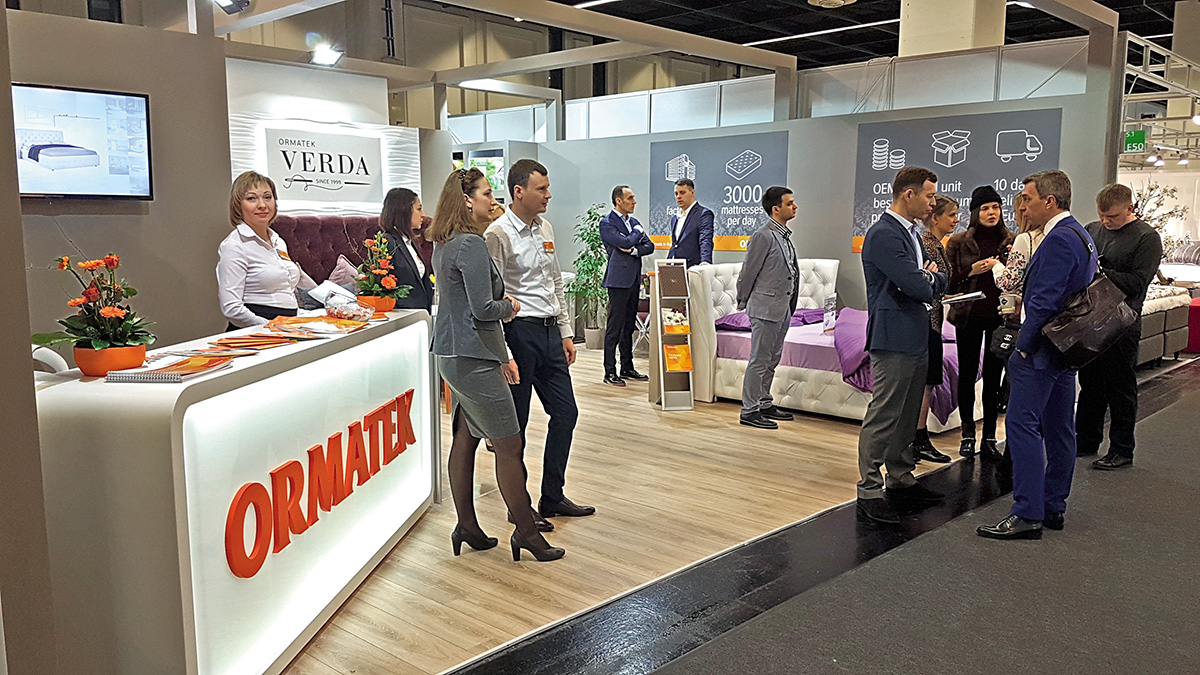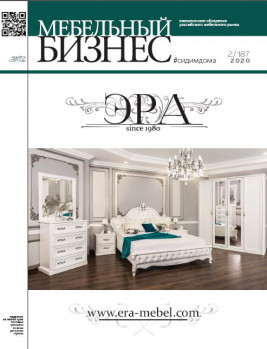What need is driving Russians abroad?
What is driving the Russian furniture makers to export today and what are their chances to succeed?
04/12/2017

“Need drove us to Europe!..” That’s how Vladimir Kupriyanov, director of the Inzensky Woodworking Plant, began his speech at the meeting of the Association of Furniture and Woodworking Enterprises of Russia (AMEDORO) many years ago. His company has changed since then, it prospers now and has been in the list of the best Russian exporters for decades.
What is driving the furniture makers abroad today and what are their chances of repeating the success of their Inzensky colleague?
As the saying goes, if it wasn't for bad luck, we would have no luck at all. If this scheme worked at least on a more or less regular basis, we would have long been a prosperous state. It is obvious that we are in need again. The stagnation of the domestic furniture demand forces us to turn our hungry gaze outwards. But this alone does not yet make it possible to explain a noticeable wave of interest in export issues, which has risen in the furniture community over the past year and a half. People ask about this, they talk about this, they do not argue about this anymore. The news about industry peers’ offsite activity is of special interest: someone took part in the Polish exhibition, someone showed their products in Dubai, someone signed a contract with the Germans, and someone concluded a contract with Iran and Saudi Arabia.
The atmosphere of pre-holiday fuss prevailed at last year’s November exhibition in Moscow. Revealing their plans, almost every second exponent declares its export ambitions. On the sidelines of the exhibition, you can hear now and then such phrases as “window of opportunities”, “new markets”. The reasons to prioritize export are as follows: weak ruble, overproduction of the boards, the wave of migration in Europe, which suddenly generated hopes for cheap furniture supplies from Russia.
Chipboard manufacturers added fuel to the fire. Here is a fragment of the speech by Ardasher Kurbansho, Director General of Kronospan.
“Today our furniture makers have all the conditions to become the most efficient and successful manufacturers in the world. Over the past three years, the chipboard market has changed dramatically. As a result, the furniture makers have enormous advantages over their foreign colleagues. In 2013, all Russian chipboard manufacturers produced all together no more than 800 designs in 10 textures. Today, we have more than 2500 designs and more than 50 textures in stock. Prices for chipboard fell from 150 euros per cubic meter to 60 euros. Russian chipboard has never been so cheap and doesn't seem to ever be. Many Russian enterprises surpass Western ones in the level of technical equipment.
One of my clients has become the largest manufacturer of children's furniture in two years. Half of the money he now earns on the export of his products to Germany. He is coming back from China today. And before China he had been to Italy and Spain, where he had opened his own divisions. This is the way our Russian furniture makers should follow.”
It seems that even the state is finally ripe for contributing to non-primary export. Established in 2015, the Russian Export Center is called upon to provide complex targeted support to export-oriented companies, without any industry restrictions. As stated in the constituent documents, the REC provides a wide range of financial (lending, insurance, bank guarantees) and non-financial services to existing and potential exporters, interacts with relevant executive authorities, prepares proposals on improving business activities in the sphere of exports and foreign economic activity, regularly working with the representatives of the business and expert community and contributes to overcoming the barriers and lifting of the “system” restrictions.”
We also know about regional programs of entrepreneurs’ foreign economic activity support. For example, The Strategy for the Development of International and Interregional Relations through to 2021 has been developed in the Ulyanovsk region. It provides, in particular, visiting business missions of Russian enterprises abroad. Thus, in April 2016 Ulyanovsk companies took part in the Iranian exhibition Projekt Iran 2016 (among the exhibitors there was the Delta+ kitchen factory and Inzensky Woodworking Plant). The plan of events for 2017 envisages similar missions to Germany, Turkey, Austria, Japan, South Korea, Vietnam, Azerbaijan, United Arab Emirates, Italy, China.
The event everybody has been talking about for a long time completes the picture. In 2017, the national pavilion of Russian furniture makers appeared at the Cologne show again after a long time.
imm cologne: like never before
Last year's exhibition in Cologne demonstrated an unprecedented increase in the number of visitors from Russia – as much as 26%! It is fair to assume that many of them came to Germany not to buy furniture (times are different now), but rather to explore business opportunities, with a focus on supplies of their own furniture abroad.
The organizer of the Russian national exposition at imm cologne in 2017 was the Moscow Expocenter with the support of the Ministry of Industry and Trade and AMPDR. Ufa Mebel (TM Zzibo), Novo Mebel (TM Parra), Grafskaya Kukhnya, Kurazh, Mebelgrad, Silva, Volgodonsk Chipboard Factory (VKDP LLC), Cherepovets Plywood and Furniture Mill and ROMARTI group of companies have been presented at the stand with total area of 164 sq m. Apart from the collective exposition, there were booths of Interdesign and Ormatek in the same hall, exhibited independently. In the seventh pavilion Almaz (TM Lubidom) from Volgodonsk was located.
“We did not participate in the collective exposition, because we have conducted negotiations with imm cologne before the representatives of the Association managed to do it, and so we got one of the best places – at the entrance to the seventh pavilion, right opposite the Kare Design stand," – says Sergey Zmievsky, Director General of Almaz/Lubidom (Volgodonsk). “This provided us with good visitor traffic. Among the guests of the stand, there were the representatives of the largest European retailers, namely XXXLutz and Kika.
We achieved the goals that we have set ourselves in Cologne. We finally established the cooperation with several German trading companies. I hope that the partnership with them will be expanded, though I know by experience how difficult it is to win the favour of European buyers. For example, it took us 7 months to sign the first contract! And before that we have already participated in imm cologne four times, we had to stand in the most unpresentable exhibition halls, had to hold hundreds of exhausting negotiations. This is a common phenomenon for the European commercial bureaucracy. They have too many suppliers.
Following the results of the Cologne exhibition, we form a stock reserve of the furniture, which was approved by Western pros (the children's Formula and Calypso first of all). Besides Austria, Germany and the Nordic countries, we are likely to significantly intensify our work in Eastern Europe and the Balkans. We are going to ship the confirmed European orders from a new warehouse in Prague.
Cologne also brought unexpected clients to us. Now we are almost at the final stage of signing a contract with a major Mongolian retailer. He ordered an exclusive consignment of the entire product line of Lubidom.
Events dedicated to the Russian-German partnership in the furniture sector were organized within the framework of the imm cologne business program. Thus, on January 17, Russian participants held a press conference, where the representatives of Kölnmesse, AMEDORO, the Ministry of Industry and Trade of the Russian Federation and the Moscow Expocenter delivered speeches, and the top managers of domestic companies Ufamebel, Courage, Parra, Silva and VKDP took the floor to present their enterprises and products to the foreign public.
During the roundtable on January 19, the representatives of the German furniture industry tried to explain to their Russian colleagues what features of the German furniture market they need to take into account when they enter it with their export offers. The German side was represented by the roundtable moderator, international editor of the leading industry magazine Moebelmarkt Helmut Merkel and the representative of the VDM industry association in Eastern Europe Alexander Oswald. In addition to the most recent market analytics, their speeches contained purely practical information – for example, what kind of furniture is of interest to certain consumer groups, and what furniture doesn’t have to be brought to Germany.”
Buy it for a song, convey at great expense
In fact, Russian presentation in Cologne left an ambivalent impression. The Germans were friendly, but they made it clear that the “cheap Russian chipboard” is not a sufficient argument to make Russian furniture sell out here in a blink of an eye.
To take advantage of favorable economic or political conditions, one must already be present in the world market and have the appropriate infrastructure there – distribution centers, warehouses, representative offices, reliable contacts.
“According to our estimates, usually at least year and a half or two years pass between the moment when the enterprise just gets acquainted with foreign markets and the establishment of the first supplies,” – says Alexander Manyonok, Director General of Hotner. “It is about two years of full-fledged daily work on the establishment of the export business. I'm talking specifically about deliveries to non-CIS countries – countries of a completely different consumer culture, a different level of business organization. A year and a half or two years only to get adjusted to this culture a little, to develop business relations, to work out the logistics. And with considerable investment at the beginning, a mistake costs much more.”
However, all this does not mean that export business is unpromising for Russian factories.
According to Elena Dymova, the head of the analytics company Dymova and Co., who has recently published a marketing research “Russian Furniture Market 2016”, there is a reason to talk about the real success of particular domestic enterprises.
“The largest exporters to the States, Poland, France and Sweden are IKEA's woodworking enterprises IKEA Industry Tikhvin LLC and IKEA Industry Vyatka LLC. The leader in shipments to Lithuania is the Nizhny Novgorod company Slavyansky Dvor, which actively develops exports to Europe. To Hungary Russia supplies the details of the bed frames – here the first place is held by the Inzensky Woodworking Plant. It is also a leader in supplies to Germany, along with Volga Plywood and Furniture Works (it supplies wooden parts of furniture). The Vologda enterprise Styling exports to China, Italy, Great Britain and France a lot. And the leaders in shipments to Ukraine are the companies UniTrade (transformation mechanisms for upholstered furniture) and Firm Mag (mattresses for beds).”
In fact, this list is much longer.
Each of the Russian companies paves its own way to the foreign market, but one thing unites all of them. It is not the need that drives them to Europe, neither is it the despair. It is, on the contrary, the awareness of their maturity and strength, their readiness to explore new horizons. For them to choose the export direction doesn’t mean to follow the trend. It is a conscious long-term strategy, based on which the goals are set stage by stage, organizational decisions are taken, and necessary and sufficient resources are allocated.
By the way, these resources are considerable. Before every entrepreneur the question arises of where to use them with a maximum of efficiency – on the export territories or on their own.
If we are ready to build warehouses and representative offices, to establish new contacts abroad, why all this cannot be done in Russia?
If we agree to re-study the foreign demand, why do not we study carefully our domestic demand that has radically changed lately?
If we are ready to shower foreign countries with cheap furniture, why have not we done it at home yet?

